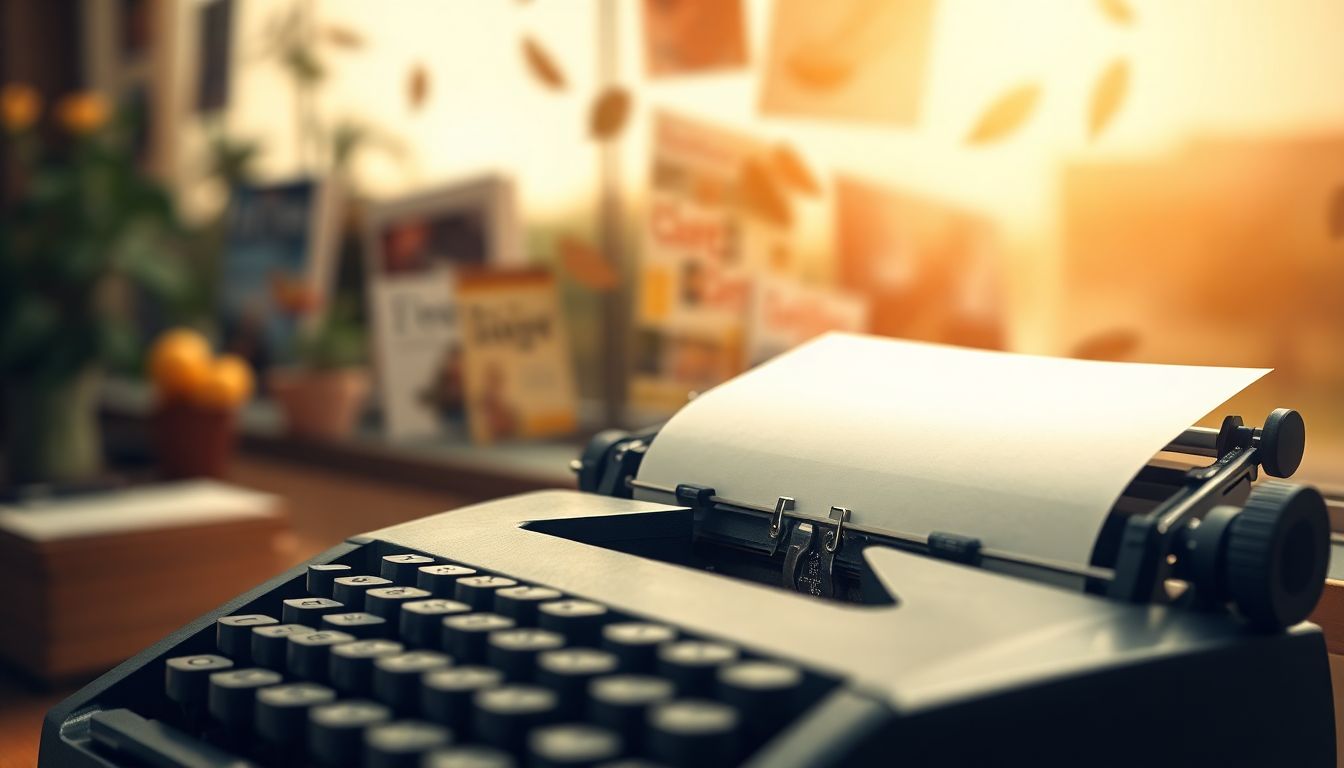Submitting your writing to literary magazines can feel overwhelming—that’s totally normal. Between finding the right mags and figuring out all their different requirements, it’s easy to feel lost before you’ve even started.
But don’t stress! This guide will walk you through each step clearly, from identifying friendly magazines currently open for submissions to formatting your work neatly, managing submission etiquette, and boosting your acceptance odds.
Ready? Time to get your writing out there!
Key Takeaways
- Find magazines currently accepting submissions using directories like Poets & Writers or platforms like Submittable.
- Always follow submission guidelines exactly, including word counts, genre rules, simultaneous submission policies, and accepted file formats.
- Polish your work thoroughly and format your submissions clearly with standard fonts and spacing.
- Consider submitting to magazines that clearly state they pay for accepted work, especially if that’s important to your goals.
- Use personalized cover letters when requested, showing genuine interest in the magazine’s content.
- Stay organized and professional by tracking all submissions, deadlines, and responses in a simple spreadsheet.
- To boost chances, study recently published pieces to better align your work with editors’ preferences.

Step 1: Find Literary Magazines Accepting Submissions Right Now
First things first, you need to find where you can send your work, because not all literary magazines are open for submissions around the clock. Many operate with specific reading periods (usually two or three months at a time), making timing crucial.
One easy way to track magazines currently accepting submissions is to use directories like Poets & Writers or websites like Submittable, which handle submission management for many journals and magazines online. It saves time, especially if you’re looking at a deadline that’s quickly approaching.
You can also subscribe to free newsletters like Authors Publish, which sends weekly updates of literary magazines actively seeking new material. This is particularly handy for writers who forget about submission timelines and can help avoid the frustration of missed periods.
Quick tip: Make sure you double-check the magazine’s website before submitting because sometimes their status changes (and not all directories catch those changes immediately).
Step 2: Check Guidelines Like Word Counts, Genres, and Submission Limits
One of the easiest ways to ensure your submission doesn’t end up instantly rejected is by carefully following each magazine’s specific guidelines. Every publication has requirements about format, length, and submission limits to keep their workflow manageable.
Typical guidelines to look out for include:
- Word counts (most short story submissions range between 1,000 and 7,500 words, while poetry submissions usually ask for 3-5 poems per batch).
- Genre restrictions (some like Dryland Literary Magazine’s submissions heavily lean toward poetry—as poetry acceptance rates are usually slightly higher than fiction).
- Simultaneous submissions (some magazines allow you to submit the work elsewhere at the same time, and others clearly don’t—which means checking this rule can save your reputation).
- File formats (commonly accepted formats are DOC, DOCX, and RTF files—never PDF unless specifically asked).
For example, Split Lip Magazine received almost 1,000 submissions last year alone—you’re facing tough competition, so following guidelines exactly could make the difference between a “maybe” and a quick “no thank you.” Save yourself the headache and stick closely to what editors actually ask for in their instructions.
Step 3: Prepare Your Writing for Submission (Fiction, Poetry, Nonfiction)
Your submission needs to stand out in an inbox packed with hundreds or even thousands of competing voices, especially when magazines like The New Yorker only accept 0.14% of unsolicited submissions each year. Making your work submission-ready means more than just spell-checking—it means polishing until your writing is clean, engaging, and professional.
Consider hiring or swapping pages with a trusted friend or critique partner to get fresh eyes on your material. This outside perspective can save you from embarrassing typos or clarity issues that you’ve overlooked by being too familiar with your work.
If you’re writing in a specific genre, reading previously published pieces in your target magazines can also help you gauge the style and quality they prefer. Pay special attention to recently published nonfiction essays, creative poetry, or fiction short stories—whichever matches your project.
Don’t forget to format your manuscript correctly because it signals professionalism when editors first set eyes on your work. Proper formatting can include basic elements like page numbers, correct margins, and an easily readable font like those listed in this guide on the best fonts for book covers and page formatting.
Essentially, your goal here is clarity and readability—make life easy for the editors and they’re more likely to read closely and consider your work seriously.

Step 4: Identify Magazines That Pay for Accepted Work
Good news—getting your work published doesn’t always mean giving it away for free.
Lots of magazines actually pay contributors, so if earning money from your writing is one of your goals, make sure you’re submitting to ones with clear payment policies.
You can usually find payment details listed plainly on the magazine’s submissions page or guidelines.
They typically pay by the piece (for example, $50 for a short story or $25 per poem), by word-count (say, 5 cents per word), or even offer contributor copies if there’s no monetary payment available.
Keep in mind that magazines with higher payment often have more intense competition and lower acceptance rates, such as The New Yorker, which accepts only 0.14% of unsolicited submissions per year.
If you’re just getting started, magazines offering any payment—even a small one—can still add credibility to your writing resume.
Step 5: Format Your Submission Clearly and Follow All Instructions Given
Editors have tons of submissions to read, so the last thing you want to do is make it difficult for them by sending a messy document.
Make your submission easy on their eyes by formatting clearly without fancy fonts or bright colors.
Standard formatting usually involves: double-spacing, using Times New Roman or Arial font sized 12 points, 1-inch margins on all sides, clear page numbering, and including your name and contact information in the header.
If poems require special formatting or structure, take extra care to ensure your document preserves that correctly—double-check by previewing your manuscript before hitting submit.
Some magazines provide specific templates or examples, and if they do, definitely use these—it shows you’ve taken the time to comply with their requirements.
You can also take cues from professional book formatting guidelines, like these recommended best fonts for book covers and page formatting.
Step 6: Write Personalized Cover Letters If Required
A cover letter isn’t always necessary, but when it is, it can help you make a great first impression—even if just short and sweet.
Resist the urge to copy and paste a generic template—you want editors to see you’re genuinely interested in their publication specifically.
Briefly mention the magazine by name and why you like their work (“I really enjoyed your recent poetry issue, especially the poem XYZ, and thought my piece might resonate similarly”).
Be concise—two or three paragraphs are usually enough to introduce yourself, briefly describe your submission, mention any previous published work if you have it, then conclude politely.
A personalized touch can tip the scales slightly in your favor, especially in competitive magazines receiving hundreds of submissions per issue, like Split Lip Magazine who had 938 submissions last year alone.
Step 7: Submit Using Preferred Platforms (Online Submission Managers)
Most literary magazines now ask writers to use online submission management platforms like Submittable or Duosuma.
Not only can these tools streamline the process considerably, but they also keep your submissions organized in one handy dashboard.
If the magazine specifically asks you to use such a platform, submit through that system only—don’t send additional emails or messages unless they encourage it.
Many platforms let you view updates or statuses like “in progress,” “accepted,” or “declined,” making it pretty easy to stay updated without constantly refreshing your inbox.
Keep track of your passwords and log-ins too, because you’ll likely use multiple platforms for different magazines.
Step 8: Manage Simultaneous Submissions Responsibly (Withdraw Quickly If Needed)
Submitting a single piece to multiple publications is called a simultaneous submission, and it’s usually allowed unless explicitly forbidden by a magazine.
However, the minute one publication accepts your work, professional courtesy dictates notifying the other magazines right away.
Doing this quickly keeps your reputation clean and maintains excellent relationships with editors—you never know when you’ll submit to them again.
The best way is to use submission management platforms—they often have simple “withdraw” buttons or mechanisms already built-in for occasions like this.
For manual withdrawals, a quick and polite email informing the editor that your work has been accepted elsewhere is appreciated.
Step 9: Keep Track of Your Submissions and Response Deadlines
If you’re sending numerous submissions, you definitely want a system for keeping track of when, where, and what you’ve submitted.
You don’t need complicated software—often a simple spreadsheet on Google Sheets or Excel will do the trick.
Include columns for the magazine name, submission title, date submitted, expected decision timeframe, simultaneous submission status, and current status (under review, rejected, etc.).
Checking the typical response times listed on magazine websites can help you get a sense of when to send follow-up queries, especially if you were explicitly asked to wait until a certain timeframe has passed.
This approach prevents forgetfulness, unnecessary follow-ups, and gives you a clear visual overview of your submission progress.
Step 10: Increase Your Chances by Reading Previously Published Work in Magazines You’re Targeting
Finally, if there’s one effective trick, it’s spending time reading recent issues of magazines you’re submitting to—and I mean really reading them.
Doing this shows exactly what the editors are into, helping you understand their tastes, preferences, tone, and genre style.
For example, Dryland Literary Magazine publishes mostly poetry (about 40 of 55 available spots), so submitting poetry rather than fiction might significantly improve your odds.
If you know your style doesn’t match a publication’s typical acceptance, no worries—move on and find another that suits your voice better.
Looking at what’s been chosen before can also inspire fresh ideas—sometimes using something as simple as seasonal writing prompts sparks a new piece that’s perfect for a particular magazine.
This investment in research will pay off with more targeted submissions and, ultimately, better success in getting published.
FAQs
Check the magazine’s official submissions page regularly or visit submission platforms like Submittable. Magazines typically post updates on open reading periods, submission windows, deadlines, and other essential details clearly on these platforms.
You can submit simultaneously if magazines explicitly allow it. Always review their submission guidelines carefully first. If your work gets accepted elsewhere, withdraw promptly from the other publications to maintain respectful relationships with editors.
Payment policies vary greatly between magazines. Some pay contributors with cash or online payment methods, while others only provide free contributor copies or online publication. Check magazine submission guidelines carefully to find details about compensation.
A concise cover letter typically includes your name, submission title, genre, brief writing background, and relevant credentials. Personalize each letter by mentioning why you chose the publication and reference previous work you’ve enjoyed from their magazine.
